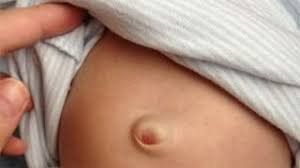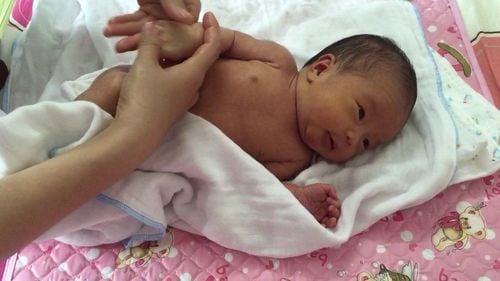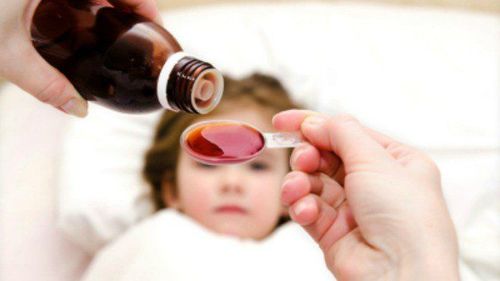The article is professionally consulted by Phan Thi Cam Van, MSc, MD - Neonatologist - Department of Pediatrics - Neonatology - Vinmec Da Nang International General Hospital.
Umbilical hernia in newborns can heal on its own. Cases where the baby's intestines are trapped, causing necrosis, are very dangerous and require immediate hospital examination and treatment.
1. What is an umbilical hernia in newborns?
An umbilical hernia in newborns is a condition where a part of the internal organs protrudes from its original position in the body. The protruding part forms a bulge at the baby's navel.
The umbilical cord is the bridge that delivers nutrients from the mother to the fetus to nourish the baby while in the womb. The umbilical cord connects to the fetus through a small hole in the abdominal wall. When the baby is born, the umbilical cord is cut. About 7-10 days later, the umbilical stump gradually dries up, falls off, the wound dries, and heals on its own, forming the baby's navel. The hole in the abdominal wall where the umbilical cord passes through gradually closes. Babies with an umbilical hernia have an abdominal muscle that can not close on its own.
Umbilical hernia in newborns is common in premature and low birth weight babies. The rate of umbilical hernia is higher in girls than in boys.
2. How to detect an umbilical hernia in newborns?
The umbilical hernia bulges at the baby's navel. Parents can detect the condition by observing or gently pressing on the navel area and feeling a bulge. When the baby is still, the hernia is small and sinks down, making it difficult to detect. The hernia becomes larger and more visible when the baby stretches, coughs, cries, or sits up. Umbilical hernia in newborns does not cause pain, so it does not make the baby uncomfortable.

3. Is an umbilical hernia in newborns dangerous?
Umbilical hernia in newborns is not a cause for concern because it usually resolves on its own, and the baby's body will gradually adapt and return to normal.
An umbilical hernia in newborns is only dangerous if a part of the intestine gets trapped in the hernia and cannot move out, causing blood flow to be restricted. Over time, this can lead to intestinal necrosis or even abdominal infection. Symptoms of this condition include abdominal pain, fussiness, and vomiting. In such cases, parents should take the baby to the hospital immediately.
4. How to treat an umbilical hernia in newborns?
In cases where the umbilical hernia can heal on its own, parents do not need to do anything and should not apply any traditional methods like sticking a coin on the hernia area, as the navel is very sensitive.
In some cases where the umbilical hernia does not cause pain but does not go away after 3-4 years, parents can take the baby to the hospital for examination. Doctors can easily push the hernia back into the abdomen.
For large and painful hernias, hernias with trapped intestines, or hernias with swollen and red skin, surgical intervention is necessary. Parents should take the baby to the hospital as soon as possible for timely examination and treatment.
To arrange an appointment, please call HOTLINE or make your reservation directly HERE. You may also download the MyVinmec app to schedule appointments faster and manage your reservations more conveniently.
To arrange an appointment, please call HOTLINE or make your reservation directly HERE. You may also download the MyVinmec app to schedule appointments faster and manage your reservations more conveniently.








